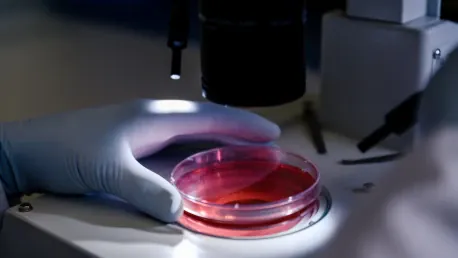In recent years, health research has been undergoing two major, yet seemingly opposing, shifts: a deep dive into individual-centric medicine and a broadened focus on population-wide studies. On the individual level, advancements in genomics are driving the shift toward personalized medicine, where healthcare is tailored according to an individual’s genetic profile, significantly enhancing disease prevention, diagnosis, and treatment. On the population level, large-scale datasets are analyzed to offer insights into the health of entire populations, influencing decisions like the allocation of healthcare resources, focus areas for screening programs, and strategies to reduce disease incidence and severity. These approaches are powerful when taken independently, but the combination of personalized and population health research has the potential to transform healthcare on an unprecedented scale. Biobanks, which store substantial amounts of biological samples for research, play a critical role in merging these two research paradigms.
Estonia’s National Biobank: A Comprehensive Initiative
Establishment and Scale
Estonia is at the forefront of such initiatives with its national biobank, gathering considerable interest from researchers worldwide. The Estonian biobank, smaller in comparison to the UK Biobank, houses around 212,000 samples, which represents about 20% of the country’s population. The population of Estonia is around 1.3 million, making this one of the most comprehensive biobank initiatives on a national level. This significant endeavor has been facilitated by the enactment of Estonia’s Human Genes Research Act in 2000, which allowed for the creation and organization of the national biobank and enabled robust genetic research.
This initiative reflects a unique model, particularly given Estonia’s smaller population. The ability to collect and manage data representing a substantial proportion of the country offers valuable insights. This allows researchers to conduct population-wide genetic research with a precision that is difficult to achieve in more populous nations. Estonia’s early decision to invest heavily in genomic sciences is indicative of the country’s vision to foster scientific innovation in healthcare. As a result, their national biobank is not only substantial but also exceptionally organized, positioning it as a significant asset in global genomics.
Transparency and Participant Engagement
The Estonian National Biobank stands out due to its transparency and direct engagement with participants, giving it a proactive edge that other biobanks could emulate. Unlike many biobanks which hold data privately, the Estonian biobank maintains an open channel with its volunteers, sharing genetic results through a newly launched participant portal. Volunteers gain insights into various facets such as their genetic origin, health-related genetic risks, and drug metabolism. If any participants are identified as being at high risk for specific genetic conditions, they are recalled for further investigation. This pioneering approach marks Estonia as a trailblazer in employing a genetics-first perspective on healthcare.
Such transparency not only fosters trust between researchers and participants but also empowers individuals with knowledge about their genetic makeup. This participatory model ensures continuous engagement, enabling participants to make informed decisions about their health and contribute actively to ongoing research. The portal serves as a tool for feedback, where participants can provide data on their lifestyle, medical history, and health outcomes, enhancing the richness of the biobank’s dataset. This bi-directional flow of information has established a partnership ethos between the biobank and its volunteers, essential for the sustainability and expansion of genetic research.
Early Successes and Impact on Public Health
Polygenic Risk Scores for Breast Cancer
One of the early and notable successes of the Estonian biobank is its study on polygenic risk scores for breast cancer. The biobank succeeded in identifying hundreds of patients with high polygenic risk scores, referring them to oncologists for mammography screening and tailored treatment plans. This initiative led to the establishment of a national polygenic screening program for breast cancer and the lowering of the age threshold for routine mammography screening amongst high-risk groups. By catching cancer early, this approach holds the promise of vastly improving prognosis and outcomes for future patients.
This program has demonstrated substantial public health benefits. The ability to predict individual susceptibility to breast cancer through polygenic risk scores has not only enabled early intervention but also optimized resource allocation for screening programs. Estonia’s experience underlines the practical benefits of utilizing biobank data to create personalized prevention strategies, which could be applied to other diseases. The integration of genetic risk scores into routine medical practice highlights a forward-thinking approach that prioritizes precision medicine’s preventive potential over its traditionally reactive stance in healthcare.
Advanced Genomic Technologies
The Estonian biobank continues to break new ground by harnessing advanced genomic technologies, such as long-read sequencing, thanks to additional funding from the European Commission and matched by the Estonian government. This technology enables the sequencing of longer DNA fragments than traditional methods, simplifying data interpretation and offering more in-depth and accurate insights into complex genetic areas such as those associated with cardiovascular diseases and cancer. The use of long-read sequencing allows the biobank to delve into the epigenome, a layer of the genome marked by chemicals that influence gene activity and expression. This can provide early disease indicators, such as predicting cancer before the development of solid tumors. By recalling participants to provide new samples, the biobank can monitor changes in an individual’s epigenetics and their disease progression over time.
This detailed analysis provides a much clearer picture of genetic variations and their implications. The investment in long-read sequencing technology demonstrates Estonia’s commitment to staying at the forefront of genetic research. Furthermore, applying these advanced techniques to monitor disease progression, alongside traditional health interventions, can refine treatment protocols and contribute valuable data for future research. Estonia’s approach underscores the importance of combining state-of-the-art technology with robust biobanking practices to push the envelope of what’s possible in precision medicine.
Pharmacogenomics and Personalized Prescriptions
Investigating Genetic Responses to Drugs
Pharmacogenomics, which investigates genetic responses to drugs, is another key area of exploration for the Estonian biobank. By combining drug history with long-read sequencing data, researchers hope to uncover the genetic changes responsible for adverse drug reactions, guiding the way for personalized prescriptions that are safer and more effective for patients. Personalized medicine optimizes treatment efficacy, reduces trial-and-error prescribing, and can minimize harmful side effects by considering an individual’s unique genetic makeup.
The collection and integration of pharmacogenomic data could significantly shift how medication is prescribed. The potential to correlate specific genetic markers with drug response will likely usher in an era where medication regimens are tailored with high precision to individual genetic profiles. This endeavor represents a considerable improvement over the traditional one-size-fits-all approach in pharmacotherapy. Moreover, by addressing the root genetic causes of adverse reactions, the biobank’s work in pharmacogenomics is poised to enhance patient safety on a broad scale.
Enhancing Drug Safety and Efficacy
The integration of pharmacogenomics into the Estonian biobank’s research framework aims to enhance drug safety and efficacy on a national scale. By understanding how different genetic profiles influence drug metabolism and response, healthcare providers can tailor treatments to individual patients, reducing the risk of adverse reactions and improving therapeutic outcomes. This personalized approach to medication management represents a significant advancement in precision medicine, with the potential to transform patient care and optimize healthcare resources.
This proactive methodology in drug prescription not only benefits individual patients but also holds promise for public health. The data generated from pharmacogenomic studies can inform national guidelines for drug prescribing, ensuring they are in line with contemporary genetic insights. Additionally, as more genetic data is accumulated, patterns will emerge that could refine even further the predictive power of pharmacogenomics. Ultimately, Estonia’s commitment to integrating pharmacogenomics into its biobank research sets a precedent that could influence similar initiatives globally, promoting a patient-centered approach to drug safety and efficacy.
Setting a Global Standard for Biobanks
Commitment to Transparency and Innovation
While the Estonian National Biobank’s extensive reach within the country sets it apart, it is the biobank’s commitment to transparency, participant engagement, and cutting-edge technology that truly makes it revolutionary. This multifaceted approach not only enhances the scope of genetic research but also facilitates the integration of these insights into practical healthcare applications, potentially setting a new global standard for biobanks. By sharing genetic results with participants and actively involving them in their health management, the Estonian biobank exemplifies the ethos of transparency.
The use of innovative technologies such as long-read sequencing affords the biobank a unique capability to address complex genetic disorders with unprecedented accuracy. This combination of transparency, participant engagement, and technological prowess creates a robust foundation for sustained advancements in precision medicine. Estonia’s model highlights the pivotal role of biobanks in translating genetic research into real-world healthcare solutions, providing a blueprint for other nations looking to enhance their biomedical research infrastructures.
Lessons for Health Systems Worldwide
In recent years, health research has seen two major, seemingly opposing shifts: an in-depth focus on personalized medicine and a broader look at population-wide studies. On the individual level, advancements in genomics are propelling personalized medicine, where healthcare is tailored to an individual’s genetic profile. This approach significantly enhances disease prevention, accurate diagnosis, and effective treatment. Meanwhile, on the population level, large-scale data sets are analyzed to derive insights about the health of entire populations. These insights help inform decisions like healthcare resource allocation, focus areas for screening programs, and methods to reduce disease incidence and severity. While powerful independently, combining personalized and population health research has the potential to revolutionize healthcare. Biobanks, which store vast amounts of biological samples, are crucial for integrating these two research approaches, bridging the gap to achieve unprecedented improvements in healthcare delivery and outcomes.









